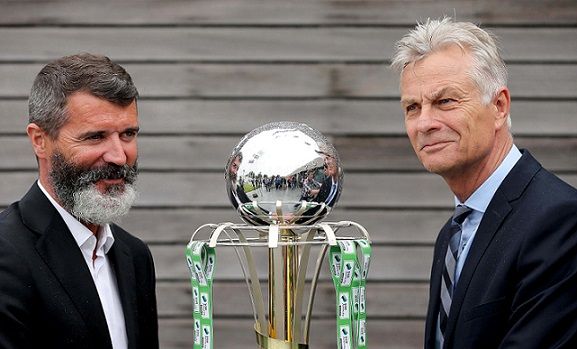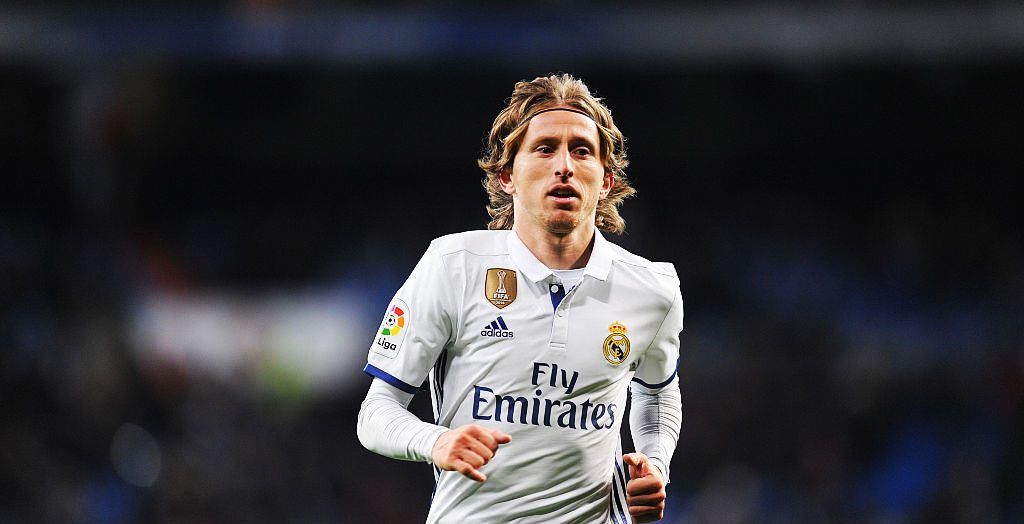Former Croatia manager Slaven Bilic and current Republic of Ireland manager Martin O’Neill got quite animated during ITV’s recent coverage of Croatia’s penalty shootout win over Denmark in the round of 16.
Croatia advanced to the quarter-finals to play Russia following the win and Bilic was given a platform by ITV host Mark Pougatch to explain what the win meant to his country.
“We are a small country,” Bilic began, only for O’Neill to interrupt.
“You’ve told us that so many times,” the Ireland boss replied before muttering some further utterances.
Bilic replied by acknowledging that Croatia was bigger than Ireland.
“Much bigger,” O’Neill added.
“Better football players,” Bilic added, the laughter of Mark Pougatch and fellow pundit Lee Dixon subsiding.
The better player remark was the nail in O’Neill’s coffin.
At a time when the Ireland manager is trialing Preston North End’s Sean Maguire up front and Conor Hourihane and Alan Browne in midfield, Croatia will play England in a World Cup semi-final with Juventus striker Mario Mandzukic leading the line and Real Madrid and Barcelona midfielders Luka Modric and Ivan Rakitic providing support in behind him.
Bilic was right in the fact that Croatia do have better footballers than Ireland but he was wrong when he said that his country is bigger.
Croatia has a population of 4.17 million compared to an Irish population of 4.77 million. Furthermore, Croatia has 130,000 participants in football compared to Ireland’s 450,000.
https://twitter.com/conormeany/status/1015716104369590272
Croatia have qualified for five of the last six World Cups and finished in third place at the 1998 tournament in France. Ireland, by comparison, have qualified for just one of those tournaments; the 2002 World Cup in South Korea and Japan.
“Croats have a natural talent for sport that will never die,” the Serbian sports journalist Aleksandar Stojanovic said before Croatia’s Euro 2004 campaign.
“They achieved greatness at football in the 1990s because they were determined to prove themselves as a nation and show their compatriots they loved their new state more than the previous one.”
Natural talent and determination can take you far but it doesn’t explain how a smaller country with a smaller playing population can qualify for five out of six world cups while a bigger country with a bigger playing population has qualified for just three major tournaments out of a possible 12 since the 1994 FIFA World Cup.
Romeo Jozak coached Croatian national underage teams from U15 to U21 level and later served as the Technical Director at the Croatian Football Federation as well as Chairman of their Technical Committee.
For Jozak success went beyond natural talent and determination. It was about establishing a clear vision and developing a system where a loss of talent was minimised.
“Football as a game has a long history in Croatia,” Jozak told Croatia Week last month.
“Many don’t remember that the Croatian Football Federation was the first such institution in former Yugoslavia.
“From there on in, the core of every big team in Yugoslavian history was made from Croatians, leading up to 1987 when the only Yugoslavian World Cup title in football had been won, with players such as Boban, Štimac, Prosinečki, and Šuker as the biggest names.
“It almost seems that from the very beginning we were destined for this game. On a more practical note, apart from the factors I mentioned earlier, it is all down to hard work. We have to make sure we don’t miss a single player with the potential to become great, be it in Croatia or in the Croatian diaspora worldwide. Find the players early and then develop them properly, that is where the coaches are the key.”
The coaching is key and Limerick FC midfielder Shane Tracy can attest to that. The former Arsenal youth player made more appearances than any other player for the club’s Under-18s side in 2005, scoring twice in 28 games for the Gunners.

Tracy was promoted to the reserve side the following season but ultimately came back to the League of Ireland and Galway United a season later while Nicklas Bendtner, Kieran Gibbs, Alex Song, Fabrice Muamba, Johan Djourou and Vito Mannone, some of his teammates from that side, would all progress to the first team or forge Premier League careers elsewhere.
“What did I learn about Irish players and their ability to compete in England? Well Irish players have the same level of talent as the English youngsters. But the coaching systems in Ireland are way behind,” Tracy told Kevin O’Neill in Where Have All the Irish Gone? The Sad Demise of Ireland’s Once Relevant Footballers.
“That’s not having a go at Irish coaches but the facilities and resources in England are so much better. The young English players are training and playing with better players and getting proper coaching from a young age.
“That’s really what we miss in Ireland and our younger players, once they get to England, are playing a massive game of catch-up.”
Tracy is far from an exemption. Statistics sourced from Extratime.ie’s League of Ireland database showed that in the 2016 League of Ireland season; 73 out of 258 Premier Division players sampled had previously either played for an English or Scottish club, or had been part of their youth system in some capacity, before returning to the League of Ireland.
There was no real signs of a better situation earlier in the decade either.
In 2011, it was estimated that 85 percent of Irish 16-year-olds would not be at the same English club within three years, while 94 percent of Irish players in England who sign a professional contract at 16 do not get another contract at the same club. Of the footballers who return to Ireland, 75 percent do not return to play in the League of Ireland.
The FAI had to try and curb this trend and they could no longer rely on British clubs to produce Irish players so they introduced the Elite Talent Programme in 2006 and the FAI Player Development Plan in 2015 in a bid to produce better footballers.
The Emerging Talent Programme was launched by the FAI in November 2006 and is the vehicle used by the Association to develop national team training themes to the elite players countrywide.
Robbie Brady and Jeff Hendrick are examples of graduates from the Elite Talent Progamme but speaking to two FAI development officers a number of issues arise including availability of players, how many times they can train per week, competition from other sports, what the predominant sport is at their local school and facilities available to them when they are not training.
However, while those are limitations for some players, for other players within the system, particularly urban based players, it can serve as a pathway from where a player can go from small sided games, coached by qualified coaches, to schoolboy football to the U15/17/19 national leagues and eventually into professional football.
The introduction of small sided games – where U6s to U9s for example play in condensed 4v4 and 5v5 games with squads no bigger than 10-12 depending on the age group and where each child is expected to play a minimum of 75% of the overall gametime – is part of Ruud Dokter’s National Player Development Plan.
The NDP was introduced by the FAI High Performance Director in 2015 with the intention of producing better football players in Ireland by comparing Irish youth structures with the youngest players in other countries including England, Spain, Germany, France, Italy and the Netherlands.
The plan includes 10 recommendations and ideas such as all underage teams should play in a 4-3-3 formation, coaches should encourage young players to play out from the back, through midfield, linking up with attack, and that there should be a player-focused model based on enjoyment and skill development to reduce the emphasis on winning at all costs.
Croatia implemented a similar overhaul of their underage structures, albeit, at an earlier stage. Ireland’s relatively small population is often viewed as a hindrance when it comes to major sporting success but Jozak actually views it as a positive when trying to get players to adhere to the one plan.
“I think it’s way easier for us in Croatia, having the population of 4.5 million people in such a small territory, to follow the unified vision,” Jozak told soccerwire in 2014.
“Yes, we do have a curriculum. Myself and people around me put it together two or three years ago, and we do follow it in all the national teams.
“It will take time to take effect in the future, but yes, I think it’s important to not necessarily play the same system — 4-3-1-2 or whatever — [but have] the same philosophy in movements, in passing, in opening.
“This is what makes it interesting: let’s say technique. They asked me how important technique is. Technique is important, but the application of technique to be functional is something else. OK, this guy is a talented guy. He can juggle the ball, can do miracles, is a clown — but he can’t apply that technique to solve problems in the game. Having the opposing team play active defense or passive defense, you’ve got to have the functional technique — not only aesthetic technique.
“That’s another thing: when you have functional technique, this technique should solve problems on the individual tactical level — if I open [my body] this way, I open that way, my angle of vision is going to be this much bigger. Functional technique is going to help you adjust those things by actually being that applicable in that way. We’ve got to educate the kids in the same or similar way.”
Jozak’s national development plan may have been introduced some years before Dokter’s overhaul took place in Ireland but the Croats have always placed a massive emphasis on technique.
Martin Novoselac, Croatia’s former head of youth football, who has coached children for over two decades, said in 2007 that technique must be prioritised over winning.
‘You cannot make a player in a moment – it is about the long-term,’ said Novoselac.
‘The most important thing is taking care over technique and making steady progress. Our boys do not play in real competitions until they are 12 or 13, and even then the result is not everything. Creativity is what matters. We are always teaching them to be creative. They will know how to shoot, play one touch and dribble. But choices are left to them. You can practise for 100 years, but if you don’t have the right feeling it’s no good.’
They have the right feeling, the right coaches, the right team and they could be the right choice for the World Cup.
Football might be coming home but Croatia has been a small home to many great footballers for a long time.
‘You cannot make a player in a moment – it is about the long-term’






































